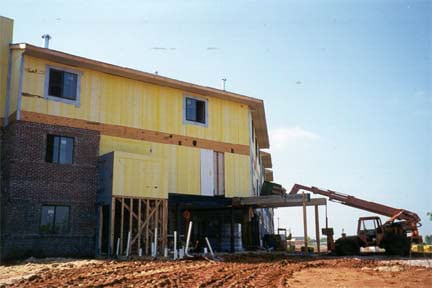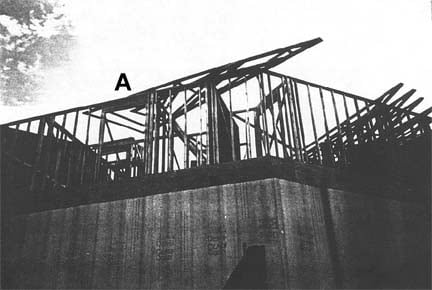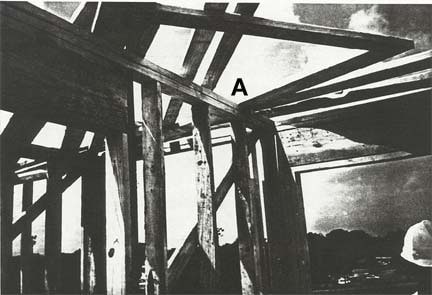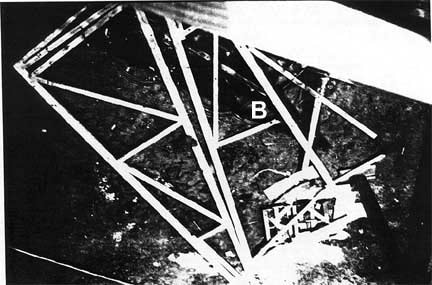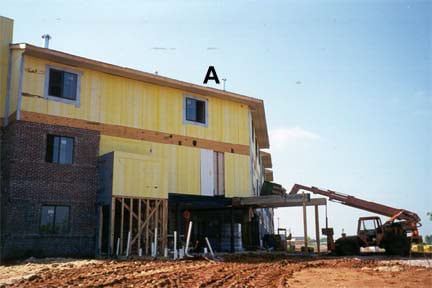A 16-year-old Died After Falling 27 Feet at a Residential Construction Site – Alabama
NIOSH In-house FACE Report 2000-16
Summary
A 16-year-old male framing construction crew member (the victim) died after falling 27 feet from the third story of a residential dormitory construction site (Cover photo). The victim was moving roof trusses that were to be anchored in place using a nail gun. He was supporting himself on an 8-inch wide structural wooden beam. The victim was not wearing or using personal fall protection equipment. When the victim fell to the ground floor inside the building, at least one of the 8-foot by 4-foot trusses fell with him or just behind him, striking his head when he impacted the ground. Co-workers notified the supervisor who immediately called 911. Co-workers and other witnesses went to the victim to assist him. Emergency responders arrived within a few minutes, and on observing the severity of the head injury, transported the victim to a local city hospital where he was pronounced dead.
NIOSH investigators concluded that to help prevent similar occurrences, employers should:
- ensure that all employees are provided fall protection when exposed to fall hazards
- develop, implement, and enforce a comprehensive written safety program
- provide comprehensive safety training to employees to include, but not be limited to, safe work practices, hazard awareness, identification, and avoidance
- ensure that workers who are part of a multilingual workforce comprehend instructions in safe work procedures for the tasks to which they are assigned
- ensure compliance with child labor laws which prohibit youth less than 18 years of age from conducting work recognized to be especially hazardous.
Additionally,
- general contractors should ensure through contract language that all subcontractors on site have appropriate safety programs.
Introduction
On April 19, 2000, a 16-year-old male construction framing crew-member (the victim) died after falling 27 feet from the roof to the ground at a residential dormitory construction site. The National Institute for Occupational Safety and Health, Division of Safety Research (DSR) was notified of the incident by the U.S. Department of Labor Wage and Hour Division. On June 5-8, 2000, a DSR occupational safety and health specialist conducted an investigation of the incident. The DSR occupational safety and health specialist visited the incident scene and interviewed the general contractor’s construction superintendent who had been present at the job site on the day of the incident, but was not at the scene at the time of the incident. The DSR investigator met with representatives of the Federal Occupational Safety and Health Administration (OSHA) and the Department of Labor Wage and Hour Division. A review of witness statements, investigating officer reports, and photographs taken at the incident site was conducted. Representatives of the subcontractor who employed the youth were not available for interview.
The victim was a member of an eight-man construction framing crew. They worked for a construction subcontractor based in Texas, who in turn was contracted by a framing construction contractor based in Oklahoma. The Oklahoma framing contractor had been contracted by the general construction contractor located in Alabama, where the incident took place. The Texas subcontractor had been working as a construction framing contractor for about 1 year. He hired his crew members on a job-to-job basis. Many were Mexican nationals who spoke little or no English. The Texas subcontractor had a written safety plan in English at the job site that covered safe work practices, but did not include a fall protection plan. The Oklahoma-based framing contractor had been in business for about 7 years and had been incorporated in the State of Oklahoma for 1 year. The general contractor had been working in construction in the State of Alabama since 1987 and employed approximately 60 people. The general contractor had a superintendent on site. The general contractor had a written safety plan for his employees and this plan did not cover the employees of a subcontractor. The site superintendent held weekly safety meetings with the general contractor’s first-line supervisors only.
Back to Top
Investigation
The subcontractor’s framing crew had been working at the residential dormitory construction site for about 3½ weeks, installing floor and roof trusses. They had been working 40-hour work weeks, working a normal day shift from approximately 8:00 a.m. to about 5:00 p.m. each day. The crew was within a day or two of completing the contract work agreement.
On April 4, 2000, the crew was putting roof trusses in place on top of the third story of the residential dormitory (see Photo 1). The weather was clear and the walkways and work surfaces were dry. A crane had just placed a stack of 4-foot by 8-foot roof trusses at the top edge of the building. The trusses were constructed of reinforced 2-inch by 4-inch lumber. Crew members were in the process of spacing the trusses out along the top of the building frame where they would be later nailed into place using a pneumatic nail gun.
At approximately 9:35 a.m., the victim was observed moving a roof truss into place while supporting himself on an 8-inch-wide wooden structural beam (Photo 2). At some point he fell 27 feet to the interior dirt floor of the building (Photos 3 and 4). The actual fall was not witnessed. The floor area to which he fell was covered with building materials and scrap lumber. One or more of the trusses fell with or just behind the victim, and he was struck on the head by a truss upon impact with the ground.
The victim was observed on the ground by a worker from another crew. Co-workers who realized he had fallen went to him to render assistance. The construction site superintendent was notified and called 911. First responders arrived within minutes of the call, and, upon observing the severity of the victim’s head injury, transported him directly to a local hospital where he was pronounced dead on arrival. A state medical examiner was called to look at the incident site and to examine the body of the victim.
The contractor’s site superintendent did order all work at the construction site to be stopped at approximately 10:00 a.m. following the incident. Because the truss work was nearly completed, the subcontractor for the framing crew was released from the job site and the crew left the state on the following day.
Back to Top
Cause of Death
The medical examiner listed the cause of death to be severe blunt force trauma to the head.
Recommendations and Discussion
Recommendation #1: Employers should ensure that all employees are provided fall protection when exposed to fall hazards.
Subcontractors have a responsibility to provide their workers with fall protection as needed and the general contractor who has control of the work site has a responsibility to ensure workers on the site are in compliance with OSHA standards. This is a difficult task in the active and fast-paced environment of a new construction site for a multi-story building. Once construction workers are working at heights at or near a leading edge which is 6 feet or more above a lower level, the construction standard requires that fall protection shall be provided and used. Investigators observed personal fall arrest system equipment available at the work site, but did not see it in use. Had this equipment been used by the victim to tie into a properly rigged life line, the fatal injuries may have been prevented. Requirements for fall protection are found in 29 CFR 1926.501 (b) (1).
Recommendation #2: Employers should develop, implement, and enforce a comprehensive written safety program.
According to 29 CFR 1926 (20) (b) (1) and 29 CFR 1926 (20) (b) (2), employers are responsible for developing safety programs for the construction site that are designed to prevent worker injury. These safety programs are to provide for frequent and regular inspections of the job site and they are to be done by a competent person trained in or experienced to perform the inspections.
The subcontractor from Texas had a written safety plan. After interviewing his framing crew with the use of an interpreter, it appeared to OSHA investigators that the employees had no knowledge of the safety plan or what its purpose was.
Recommendation #3: Employers should provide comprehensive safety training to employees to include, but not be limited to, safe work practices, hazard awareness, identification, and avoidance
According to 29 CFR 1926 (21) (b) (2), employers are required to instruct each employee in the recognition and avoidance of unsafe conditions and the regulations applicable to the work environment. Employers should provide task-oriented training to ensure safe work practices. There was no record that the framing crew had received any safety training. They were using some safety equipment such as head protection. It is essential that all workers at a construction site have safety training. Training in work practices that are prohibited for minors is prudent when youth less than 18 years of age are employed at a site.
Recommendation #4: Employers should ensure that workers who are part of a multilingual workforce comprehend instructions in safe work procedures for the tasks to which they are assigned.
It is not known if language barriers contributed to the incident. It is known that the victim and most of his crew members spoke or understood little English. The immediate supervisor, the subcontractor from Texas, spoke little English himself; however, it did appear to investigators that he had a fair understanding of the English that was spoken to him. The framing contractor from Oklahoma had an employee working at the construction site who spoke little or no Spanish; however, witness accounts indicated that he did have some working communication with the framing crew and their supervisor, the subcontractor from Texas. Recommendations that could improve safety on a multilingual job site include the use of interpreters and bilingual or multilingual safety programs, safety signs and posters.
Recommendation #5: Employers should ensure compliance with child labor laws which prohibit youth less than 18 years of age from conducting work recognized to be especially hazardous.
During the conduct of the investigations made by all officials at the time of the incident, it became clear that none of the contractors had a good understanding of the Department of Labor Child Labor Laws.
The Fair Labor Standards Act prohibits minors under the age of 18 from performing roofing construction operations (Hazardous Occupation Order 16). Roofing operations are defined as “all work performed in connection with the application of weatherproofing materials and substances such as rolling out tar-paper and or the actual nailing of the shingles in place, installation of metal flashing, maintenance repairs, painting of roof areas, etc.” Witnesses reported that the victim had used a pneumatic nail gun and had cut lumber with a circular saw. The use of power-driven woodworking machines is also prohibited by federal child labor laws (Hazardous Occupation Order 5).
Employers need to have a comprehensive knowledge of the Child Labor Laws if they employ youth under the age of 18 years. It would be prudent for employers at a construction site to have a system put in place to verify that every new employee entering the construction site meets all legal employment requirements for the jobs assigned.
Additionally, general contractors should ensure through contract language that all subcontractors on site have appropriate safety programs.
The subcontractor that employed the victim did have a written safety plan; however, the plan was written in English and evidence indicated that the crew understood little or no English. Evidence gathered during OSHA interviews of the crew members indicated that the crew had no knowledge of the safety plan. General contractors should ensure through contract language that all subcontractors have comprehensive safety programs that appropriately address the tasks their workers perform. As previously stated, in this instance a bilingual or multilingual safety program may have allowed the workers to better understand the safest way to perform the framing work.
Back to Top
References
- Code of Federal Regulations 2000th edition. 29 CFR 1926.501. U.S. Government Printing Office, Office of the Federal Register, Washington, D.C.
- Code of Federal Regulations 2000th edition. 29 CFR 1926.20 (b) (1). U.S. Government Printing Office, Office of the Federal Register, Washington, D.C.
- Code of Federal Regulations 2000th edition. 29 CFR 1926.20 (b) (2). U.S. Government Printing Office, Office of the Federal Register, Washington, D.C.
- Code of Federal Regulations 2000th edition. 29 CFR 1926.21 (b) (2). U.S. Government Printing Office, Office of the Federal Register, Washington, D.C.
- DOL [1991]. Child Labor Requirements in Nonagricultural Occupations Under the Fair Labor Standards Act, U.S. Department of Labor, Employment Standards Administration, Wage and Hour Division, WH-1330, revised September 1991.
Investigator Information
This investigation was conducted by Gregory J. Smith, Safety and Occupational Health Specialist, NIOSH, Division of Safety Research, Surveillance and Field Investigation Branch, Fatality Assessment and Control Evaluation Team.
Photographs
The FACE investigation project is the cornerstone of the overall NIOSH program to prevent occupational fatalities. The objectives for this effort include the investigation of occupational fatalities to assess and characterize the circumstances of these events in order to develop succinct descriptive and evaluative reports for distribution to occupational safety and health groups across the country. This work is being conducted by the FACE investigation team. It is expected that the reports alone will have a major impact by better defining the causal factors behind occupational fatalities, calling national attention to the problem, and providing insights into the prevention efforts that are needed. However, the program does not determine fault or place blame on companies or individual workers.

